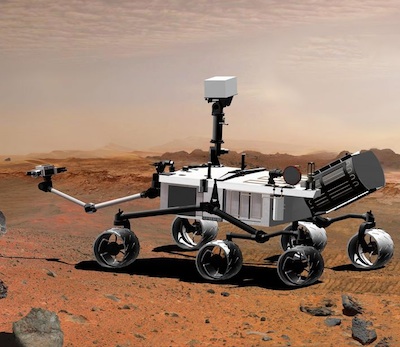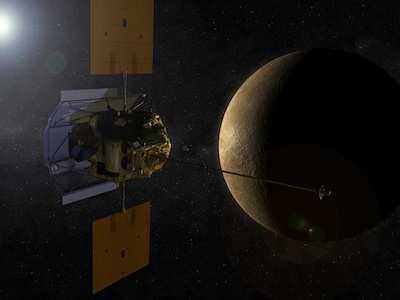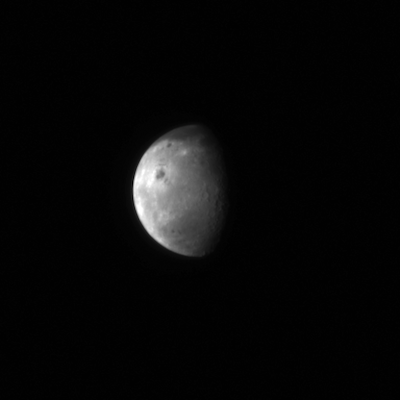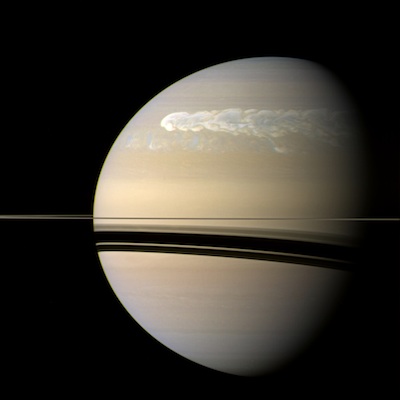 This week’s Science Saturday dispatch looks at how Washington budget cuts could be bad news for the future of human spaceflight, but NASA’s robotic efforts showed promise this week with a first around Mercury and showing us a cool storm on Saturn. We also are getting a close look at the ‘super moon’ for the weekend and watch Germans simulate weightlessness by dropping stuff. All that plus an Archimedes death ray and floating cars!
This week’s Science Saturday dispatch looks at how Washington budget cuts could be bad news for the future of human spaceflight, but NASA’s robotic efforts showed promise this week with a first around Mercury and showing us a cool storm on Saturn. We also are getting a close look at the ‘super moon’ for the weekend and watch Germans simulate weightlessness by dropping stuff. All that plus an Archimedes death ray and floating cars!
Slashed NASA Budget Could Mean No Flagship Missions in the Next Decade
During a meeting with the Planetary Science Subcommittee of the NASA Advisory Council last week, Jim Green, Director of the Planetary Science Division made it clear that he estimates only $1 billion will be available for a flagship mission in the next decade. To put that number in perspective, the Mars Science Laboratory, the flagship mission which NASA is getting ready to launch, cost $2.4 billion. The top priority flagship mission for the coming decade is MAX-C, a Mars mission that would collect and cache samples for later return to Earth. MAX-C has a $3.5 billion price tag that could be reduced to $2.5 billion. With only $1 billion to spend, NASA may not be able to launch any flagship missions in the next 10 years.
Moreover, the battered NASA budget is causing problems in Europe. Because of it’s limited finances, NASA has had to pull out of missions that have been developed in a partnership with ESA, leaving the Europeans to decide whether they can foot the bill alone.
The new NASA budget is causing the agency to take a step back and rethink the way they do business. But, are these cuts too much? Are we starting to see the end of NASA as we know it? It is hard to imagine NASA with no manned launch vehicles and no large-scale planetary missions. But, it looks like that is what we are about to get.
Read the Decadal Survey in its entirety here.
Watch the Decadal Survey address here.

The MSL Rover — NASA’s last flagship mission for the next 10 years?
NASA MESSENGER Spacecraft Achieves Orbit Around Mercury
NASA’s MESSENGER is the first spacecraft to successfully achieve orbit around our Solar System’s innermost planet. Orbital insertion was completed at approximately 9 p.m. EDT on Thursday. For the next several weeks, scientists will be monitoring MESSENGER to assure that its systems continue to work properly in Mercury’s harsh thermal environment. The instruments will be switched on March 23rd, and, once they are all checked out, the missions primary science phase will begin on April 4th.

MESSENGER in orbit around Mercury (click to embiggen)
image credit: NASA

Bonus image: The moon as seen by MESSENGER
More at LROC
Look, Up in the Sky! It’s Super Moon!
Tonight, March 19th, the full moon will appear larger in the sky than usual. This is because the moon is not only full, but at the closest point in its orbit to Earth, a point known as perigee. Tonight’s “super perigee” moon will be the biggest in almost 20 years. “The last full Moon so big and close to Earth occurred in March of 1993,” says Geoff Chester of the US Naval Observatory in Washington DC. “I’d say it’s worth a look.” Perigee moons appear about 14% larger and 30% brighter than lesser moons that occur at the farthest point in the moon’s orbit, apogee.
As the video below points out, don’t forget that the moon (super or not) does NOT cause natural disasters.
Weightless* in Bremen: Germany’s Anti-Gravity Machine
With their “Drop Tower”, the Center of Applied Space Technology and Microgravity in Germany has answered the question: how can we achieve weightlessness* on Earth? The Drop Tower is just that, a 146-meter high tower in which experimental capsules are dropped from one end to the other. Each experiment lasts only a maximum of 9.3 seconds, but that’s long enough to observe some funky behavior when matter is freed from the pull of the Earth. The video below demonstrates the process.
*99.99999% (microgravity equivalent to 10-6g)
Pic of the Week: Storm on Saturn
In early 2011 NASA’s Cassini spacecraft took several high-resolution panoramas of the enormous storm that developed in Saturn’s northern hemisphere. The first photo below is a true-color view of Saturn and its huge storm on February 25th, 2011. The second image is a high-resolution panorama taken in an infrared wavelength in which Saturn’s methane atmosphere is relatively transparent, yielding tremendous detail of the storm. (via The Planetary Society)

True-color image of Saturn and its storm (click to embiggen)
Photo credit: NASA/JPL/SSI/color composite by Ian Regan

Infrared panorama of the storm (click to embiggen)
Image credit: NASA/JPL/SSI/mosaic by AstroO
Video of the Week: Archimedes-style Solar Death Ray
The legacy of Archimedes lives on thanks to 19-year-old inventor Eric Jacqmain and his solar death ray made from 5,800 mirrors. I give you: the R5800. Unfortunately, the R5800 was destroyed in a storage shed fire in December, 2010. Jacqmain says the death ray was probably the cause of the fire. Next, he plans to build a second death ray using 32,000 mirrors!
Gadget of the Week: Floating Cars!
Researchers from Germany’s Dresdner Leibnitz institute are working to create cars that could float along a track powered by supercooled magnets. Ludwig Schultz, head of the institute, sees this as the transportation of the future. He sees cities installing networks of these cars, which require very little power to run, making way for a whole new form of public transit.
Thanks to Rene Bernhard for the translation!
Science Bytes
Not enough science for you? Here’s a warp-speed look at some more science tid-bits that are worth a peek.
- New blood analysis chip could lead to disease diagnosis in minutes
- Deserts on Titan get a dose of methane rain

A floating car?? Ooooh, gimmeee!!
Did I miss the translation…
The moon is rather mahoosive tonight!
Everytime I read something about the NASA budget it seems like someone wants to cut it to nothing.
I have to put the validity of the archimedes death ray video into question. Mythbusters has attempted that not one, not two, but THREE times and every time they added more and more mirrors, I think their last attempt was something like 4-500 mirrors and they couldn’t even turn it into a lethal weapon with THAT…
There will be Howling of the Moon tonight. Warewolves will be out in force more the usual. Also. We will all be Mooned!!!!!.
Well, so long NASA. You were fun while you lasted.
Maybe private enterprise (no pun intended) can pick up the slack.
Looking back at its history, NASA has achieved some incredible things, the moon landings being at the top of the trophy case. But somewhere along the line the good boys and girls in Houston lost their… shall we say… swagger. Nothing against scientists, but when you go from hitting golfballs on another world to going all nuts about some arsenic at the bottom of a lake you may want to consider that your organization has taken a wrong turn towards dullsville. One look at the NASA Channel (AKA: The Insomnia Treatment Network) seems to support this theory.
Inject NASA with a little more Mercury (as in Project Mercury) sex appeal and a little less arsenic and old lace and the funding—the big funding—may return.
“No bucks—no Buck Rogers.”
Now they only have 4 years to give those cars wheels that fold down…
That crazy kid is pointing the death ray at Saturn.
Impressive skill there in translating the German floating car video into German.
“Jacqmain says the death ray was probably the cause of the fire.” 40,600 years bad luck?
The weightlessness tower seems like the basis for a really awesome roller coaster… :)
Supermoon was beautiful last night, I wish I’d taken photos.
While I am all for NASA funding, perhaps it is a good thing that the Flagship-class missions are being curtailed. They have largely been boondoggles that are everybody else’s lunch.
In the 1980s, the Flagship-class mission was the Galileo mission to Jupiter. Galileo lost its ride into space after the Space Shuttle Challenger accident and the resulting cancellation of the Shuttle-Centaur upper stage rocket. That meant Galileo had to use a less powerful IUS rocket and a circuitous route around the inner solar system to pick up speed (“slingshot”) out to Jupiter. Unfortunately, TRW forgot to increase the lubrication on the antenna to account for the higher temps in the inner solar system, and the antenna refused to open after launch. The result: instead of thousands of TIF-quality images from Jupiter, Galileo could only send back 1/10th as many JPGs.
In the 1990s, the Flagship program was to give us Cassini to Saturn and its twin CRAF to a Comet and Asteroid. Massive budget overruns forced CRAF to be canceled, leaving only Cassini.
In the 2000s, the Flagship-class mission was the Mars Science Laboratory rover. That Rover is now approaching 200% overbudget and two years behind schedule. They plan to launch in November, but it needs still more money. MSL will use a landing system on Mars that, from the looks of it, seems insane. It could very easily bite the dust, leaving nothing for the $3 billion spent on it.
Other “giant” missions that were not officially Flagships but cost as much include the Hubble Space Telescope, which was built and launched with a flawed primary mirror that rendered most of its first three years of service useless and required expensive redesign and replacement of its instruments by expensive Space Shuttle missions just to get it to work right.
Hubble’s replacement, the James Webb Space Telescope is now pushing 100% overbudget (it has cost twice as much as planned) and will now launch no earlier than 2015, instead of 2012 as originally planned. But it needs more cash just to make 2015. This is why the Flagship Program is being cut by $1 billion.
Maybe we should just dump the Super Flagship Mega Battlestar Galactica missions and just use that money for lots more Spirit and Opportunity rovers, Messengers to Mercury, Kepler planet hunters, and the life, all of which cost a fraction of the Flagships.
I always thought Saturn couls use a little character.
13… That should read “eating everybody else’s lunch”,
I think NASA needs to get their images right when presenting science…The photo they were showing of the full moon in every instance was upside down. This is the image of the moon when it is setting in the Northern Hemisphere. When the moon rose at 7:44pm EDT (local time for my location), it didn’t look like the image presented by NASA, it was flipped where the mare was on top.
It’s a shame about NASA. I’ve always believed mankind is at it’s best when it is looking outward (whether it be the exploration of the 15th and 16th centuries or the missions to the moon). Unfortunately, we have become very insular. Part of it was the waste of time of the space shuttles. After going to the moon, sending mission after mission into low Earth orbit just was not enough to generate excitement. It was too the point a shuttle launch was barely a footnote on the evening news. People could get excited easily about manned missions to Mars and elsewhere. Not so much excitement in seeing how fish react in low Earth orbit or some such thing.
It’s sad when you seen a movie like 2001. Back in 1968 many people genuinely thought that kind of space travel would be possible by 2001. Star Trek thought there would be Martian Colonies by 2018 (according to an episode of TNG). Right now it does not look like we’ll be there even by 2118,
Unfortunately Americans have nothing to look forward too in exploration. Some of our greatest technological achievements came as a result of the Apollo program. It looks like the USA is in for a prolonged period of lackluster progress and stagnation. I was not a big fan of President Bush. However I will give him credit for finally establishing a new goal for NASA, a mission to Mars, something NASA desperately needed. Maybe a lofty goal, but for a few short years I thought that NASA finally was on it’s way to doing some much needed manned exploration. Now it looks like we’ll be lucky to see any manned missions beyond Earth orbit in our lifetimes. I’m a full supporter of getting private enterprise involved. Private companies may invest in colonies and establishing commerce. But they are just not going to invest in the initial exploration necessary to undertake colonization.
Even as late as the 1970’s, I was convinced that some day I could take a vacation on the Moon.
NASA, you have disappointed me, but perhaps it’s not your fault. Perhaps it’s our fault for believing in the optimism there was in the early days of the Apollo program.
In retrospect, Apollo itself did not start off well. We still remember Grissom, White, and Chaffee, even though the American public may have forgotten.
When Apollo 11 achieved its main mission, our hearts leapt with joy. When Apollo 17 splashed down, I did not believe that it would be decades before Americans would land again on the Moon. Yet here we are, in 2011, 39 years later, and Project Constellation is basically dead. The last footprints on the Moon will be a half century old before new ones are created.
The future is not what it used to be.
#19
+1
19. President Obama increased NASA’s funding for FY10 and has called for a flat NASA budget over the next few years in an age where everyone else is having their budgets severely cut. President Obama canceled the unaffordable Project Constellation and called for commercial companies to take over the Earth-to-Space leg of manned spaceflight so NASA could concentrate on exploration. To say Congress hated that idea would be an understatement. Congresscritters came out of the woodwork to say how unsafe commercial space would be and how they weren’t up to the task, etc. Then SpaceX successfully launched its first Falcon 9 rocket last June, and then launched its first Dragon spacecraft on the second Falcon 9 in December. With every passing day, it is looking more and more like President Obama was on the right track and Congress was flat-out wrong.
19–Actually the budget cutting for NASA began decades ago with President Nixon. He ended the Apollo program in favor of Skylab (what a great investment that was). That trend continued under President Carter and it seemed frozen in place under President’s Reagan, Bush and Clinton. They had enough money to run the shuttle missions but not enough to do anything that excites anyone outside the scientific community.
The real problem is that they should have continued pushing outward. They needed to keep the public excited about space exploration. We should have established colonies on the moon after the Apollo program then started working on a mission to Mars. When going to the moon stopped, people had nothing to get excited about. It stagnated. Anything that doesn’t grow dies. NASA is dying. When we have to hitch a ride with Russia to get to space, that is a sad state of affairs for the United States. We as a nation are in a decline. This is not a Republican or a Democrat problem. To me the political parties are a virus. They are more concerned with “getting reelected” then doing what’s right. The space program is just the lastest victim of our politics as usual. Until voters start voting for the person and not the stupid, damned party, we will continue to decline. Anyway, that’s my rant.
#21 Obama is only using NASA’s budget to push his green energy agenda now and it has nothing to do with space exploration.
I’m not turning this into a Dem or Repub issue. The fact is, politicans are swine regardless of whether they are left or right of any issue. #22 is correct.
The question is, why is the United States grounding itself and becoming dependant on the RUSSIANS for manned spaceflight? The politicians are the problem and no election will ever change that. Its like they go to Washington and take a brain death drug the moment they get there.
The transit car system in Logan’s Run are about to become reality!
If only the Vulcans would make First Contact with us instead of waiting for mankind to develop warp speed. Then every country on the planet would be looking to the stars. :-)
But seriously, I’ll say it again. Discovery of extraterrestrial life will cause nations to increase their budgets for space exploration. Of course, that requires the discovery of alien life. Sigh. One can dream.
23. Agreed, this is not a Republican versus Democrat issue. It is strangely one of the few issues that has advocates and opponents from both sides of the aisle. The violent reaction to President Obama’s cancellatioin of Project Constellation, for example, came when Congress was still totally controlled by the Democrats. President Obama’s support for commercial space is something about which, theoretically, Republicans should be very enthusiastic. But because Mr. Obama endorsed it, they’re not. Can you say “our Government is hugely dysfunctional”? I knew you could.
22. SkyLab long predates President Nixon. It began as the Apollo Applications Program in 1965 under LBJ. SkyLab was the only survivor of NASA’s long-term plans when LBJ slashed NASA’s budget in the summer of 1967. That budget massacre also ended production of the Saturn V rocket at No.15, which would have ended Apollo at Apollo 20. In 1969, Nixon canceled Apollo 20 to free up a Saturn V to launch SkyLab. Apollos 15 and 19 were canceled a few months later to save money, and Apollos 16-18 were renamed then 15-17. Nixon could theoretically have restarted Saturn V and Apollo production in 1969-70 (NASA tried to get him to) but there was almost no political support in Congress for doing so, in the wake of the Apollo 11 landing and its “we won, why do we need to go back” philosophy. Nixon instead supported the Space Shuttle, which was to greatly reduce the cost of going into orbit (it completely failed to achieve that goal.) Congress approved the Space Shuttle in April 1972 while Apollo 16 was on the moon.
Stick a fork in em. They’re done.
What’s Going down i’m new to this, I stumbled upon this I have discovered It absolutely useful and it has helped me out loads. I am hoping to contribute & aid other users like its aided me. Great job.